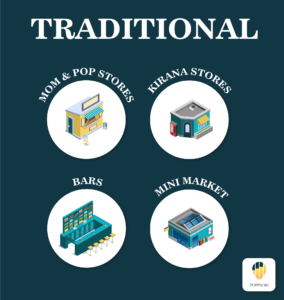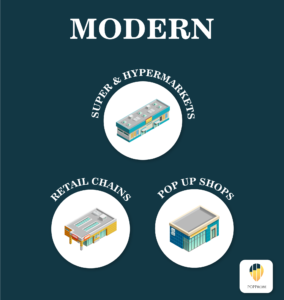Modern Trade Channel Targets for CPG Company
A CPG company should define its execution strategy based on a retail trade channel & it’s sub-channels. Predominantly, there are retail three trade channels that should be considered: Traditional, Modern, and On-Premise. It’s a known fact that product categories may flourish in one trade channel while they fail to thrive in another. So, a clear understanding of each trade channel is a prerequisite. Let’s look at each channel.

Traditional Retail Trade Channel
The traditional trade channel is crucial for CPG success. Coca Cola, for example, observed 38% sales from their traditional channel last fiscal year in the Carribean. Also, Brand loyalty is more at traditional outlets as the number of facings and competitor products available at their counters is less.
For example, Kingfisher beer is popular in the Indian subcontinent across all income classes. That’s the first choice for any beer lover who goes to a local bar. Similarly, in the US, shoppers at a deli shop prefer the same bread or sandwich for many years. In the recent news, Amazon started leveraging Kirana stores for procurement and delivery of groceries.
While it is a daunting task for a traditional store to take on big-name retailers in big cities and popular areas, they are the go-to stores in smaller cities, towns, and villages. A consumer or customer gained at a traditional market will most certainly choose the same brand even in super and hypermarkets.
Therefore, as a CPG company, if you have to expand your reach beyond the modern trade channel, then you create an effective execution strategy to target the shoppers at traditional stores. The four subchannels in traditional trade are:
Mom & Pops —
In most of the English speaking nations and the west, local stores run by a family or an individual are known as Mom & Pop Stores.
Kirana Stores —
Mom & Pop Stores in India are known as Kirana stores . Lately, due to their broad reach and high potential, Kirana stores have become monetary/lucrative targets for corporations such as Reliance, Amazon, and Walmart. New portable POS machines created by these large corporations for Kirana vendors has improved businesses of these local retailers.
Mini Markets —
Slightly larger than a typical Mom & Pop Store, these stores have a couple of aisles but display fewer brands. They also have a POS system to record all its transactions.
Bars —
Any alcoholic beverage company should concentrate on Bars as a primary trade channel, as they are popular hangout destinations for locals. Most of the beverages, especially beer, gets a significant amount of exposure at bars.
Modern Retail Trade Channel

Every CPG company targets the modern trade channel to get the exposure required for its brand and SKUs. Modern stores get a lot of foot traffic daily. Be it a new brand or an established CPG behemoth; these retail stores give them a bigger platform to gain a customer base.
Since their inception, the retail stores attracted huge crowds through innovative promotions such as Diwali sale, Christmas sales, and more. These stores primarily exist or pop up in bustling areas of a city. Many new brands can utilize these stores and their related promotions to reach out to consumers. Also, conversion opportunities are quite high, leading to retail success.
As part of the retail execution strategy, brands should work on gaining maximum visibility in these stores. Leaders of both parties- manufacturers and modern stores — must negotiate the approach in joint business discussions to extract the maximum results. These mutual relationships are crucial than ever before.
These are the sub-channels of the modern trade:
Super & Hypermarkets —
Walmart, 7-Eleven, SPAR, and Aldi are some of the many hypermarket chains around the world. These departmental stores require hundreds of acres to complete and run their establishments. Even with the rise of the digital era, the foot traffic at these stores remains consistent.
Retail Chains —
Smaller in size compared to super & hypermarkets, but they have multiple retail outlets across the city, state, and country. Names such as Melcom, C&A, Reliance fresh, and Padini belong to this category. They may not have acres for their establishments, yet they are big enough to sell your merchandise and promote your brand.
Pop Up Shops —
The talk of the town in the 2010s! Pop Up shops allow shoppers to experience a brand’s products. Apple, Unilever, Coca Cola, and even smaller brands have taken advantage of the pop-up model. The subchannel is here to stay. Enhance your execution strategy to suit this business model.
On-Premise Retail Trade Channel
On-premise establishments attract families, friends, and the general public. They are a great source of visibility and promotions for FMCG brands that deal in dining & entertainment. Brands can effortlessly expose themselves to a more massive crowd and not just shoppers.
If you’re a CPG company with food or beverages as your product, then on-premise marketing is pivotal for your success. The retail execution strategy must include the following sub-channels:
Cafeterias —
Food courts in shopping malls & corporate offices, canteens, and refectories fall under this category. Hundreds to thousands wander these grounds daily for multiple purposes; some to eat, some to drink and some to just hangout.
Local Eating & Drinking —
Fast food chains, restaurants, and local eateries enthrall the public. And so, they experience high amounts of foot traffic. Promotion and merchandising deal in this space will increase sales exponentially.
Bakeries —
Bread, Biscuits, Cakes, and Confectionaries are everyday requirements in many parts of the world. While bread is the daily meat for some, the others are probably ordering cakes for birthdays, parties, anniversaries and more — a perfect destination for a brand which deals in the confectionery space.
In Conclusion
Every CPG brand out there should consider these trade channels and develop their retail execution strategy based on the channels they want to concentrate on. Failing to do so will result in unsatisfactory results.



